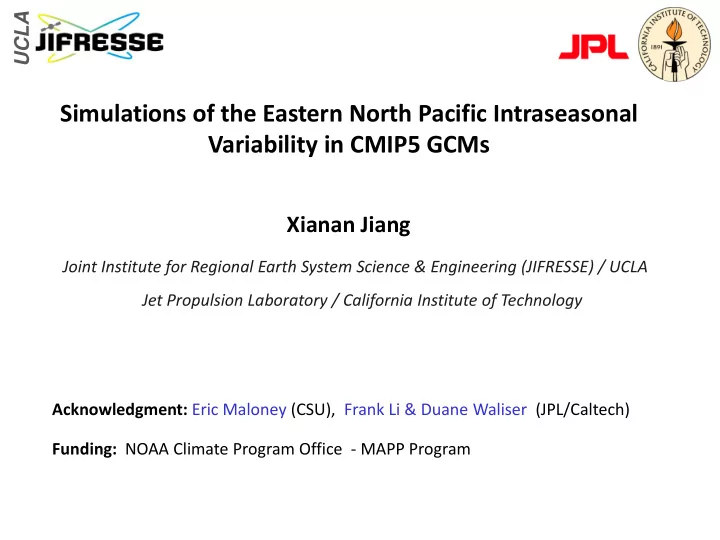

UCLA Simulations of the Eastern North Pacific Intraseasonal Variability in CMIP5 GCMs Xianan Jiang Joint Institute for Regional Earth System Science & Engineering (JIFRESSE) / UCLA Jet Propulsion Laboratory / California Institute of Technology Acknowledgment: Eric Maloney (CSU), Frank Li & Duane Waliser (JPL/Caltech) Funding: NOAA Climate Program Office - MAPP Program
I. Introduction - Regional Impacts of ISV over the Eastern Pacific Central America Caribbean Precipitation Mid-Summer Drought (Martin & Schumacher 2011) (Magana et al. 1999; Small et al. 2007) North American Monsoon (Lorenz & Hartmann 2006) Caribbean Sea LLJ (Serra et al. 2010) Gap Winds “Gulf Surge Moisture Events ” (Maloney & Esbensen El Nino Development 2003) (Vintzileos et al. 2003) El Nino Tropical Cyclone Maloney & Hartmann (2000a,b) Higgins & Shi (2001)
Evolution of the leading ISV mode (40-day mode) over the ENP Day 0 12 Shading: Rainfall Vectors: Surface wind Signals from west; 15 3 Enhanced convection westerly wind anomalies; Critical role of latent heat flux for the ENP ISV ( Malonery & Esbensen 2003 ) 18 6 Summer mean surface wind 21 9 Jiang & Waliser (2008)
Eastward Propagation of ENP ISV mode (5 o N-15 o N) (10 o S-15 o N) ~ 4 deg/day day Jiang et al. (2011) (130-90 o W) ~ 0.65 deg/day Northward Propagation day Jiang & Waliser (2008)
II. GCM Fidelity in Representing ENP ISV
CMIP5 models analyzed in this study
Summer Mean Rainfall and 850hPa Winds
Summer mean zonal wind over the ENP warm pool CSIRO_Mk3 OBS MPI_ESM_LR HadGEM2_CC Westerly Summer mean u-wind Easterly CNRM_CM5 HadCM3 MRI_CGCM5
Taylor Diagrams for Summer mean rainfall, 850hPa winds U850 Rain V850
STD of 10-90-day filtered rainfall (May-September)
Complex EOF (CEOF) analysis (Barnet 1983; Horel 1984; Maloney et al . 2008) 𝒗 𝒌 𝒖 TRMM Rainfall (j – spatial position; t – time) 𝑽 𝒌 𝒖 = 𝒗 𝒌 𝒖 + 𝒋 û 𝒌 𝒖 û 𝒌 𝒖 -- quadrature function / Hilbert transform of u j (t) Spatial amplitude of CEOF 1 Spatial phase of CEOF 1
Spatial Pattern of CEOF 1 Amplitude
Spatial Pattern of CEOF 1 Phase
GCM skill for CEOF 1 Amplitude and Pattern (140-80 o W; 5 o N-25 o N)
Evolution of Rainfall & 850mb winds of the leading ENP ISV mode CNRM_CM5 Had_GEM2_CC MPI_ESM_LR OBS CSIRO_Mk3 MRI_CGCM3
Eastward Propagation Associated with the ENP ISV
GCM skill for CEOF 1 Amplitude and Pattern Strong easterly mean flow (> 4m/s) Westerly or weak easterly mean flow (< 1.5m/s)
Surface latent heat flux & 850mb winds at day 0
III. ENP ISV in future climate
Changes in Summer Mean Rainfall
Spatial Pattern of CEOF 1 Amplitude in future climate CCSM4 HadGEM2_CC HadGEM2_ES MPI_ESM_LR Present Future Difference
IV. Summary • Among the sixteen CMIP5 GCMs examined in this study, only seven GCMs capture the spatial pattern of the leading ENP ISV mode relatively well, although even these several GCMs exhibit biases in simulating ISV amplitude. • Analyses indicate that model fidelity in representing ENP ISV is closely associated with ability to simulate a realistic summer mean state. The presence of westerly or weak mean easterly winds over the ENP warm pool region could be conducive for more realistic simulations of the ISV. • Analyses based on multi-model simulations suggest that the ISV could be sustained over the ENP basin without the forcing from the eastward propagating MJO over the Indian Ocean / western Pacific.
Reference: Jiang, X., E. Maloney, J.-L. Li, and D. E. Waliser, 2012: Simulations of the Eastern Pacific Intraseasonal Variability in CMIP5 GCMs, J. Climate, accepted pending revisions. Thank you !
Recommend
More recommend